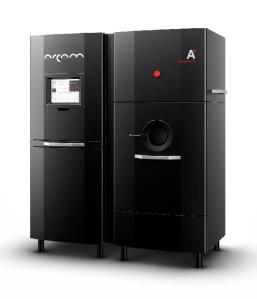One of the reasons owners come to Harrysson and Marcellin-Little is when a beloved pet gets osteosarcoma, a cancer of the bone. Veterinarians can receive the diseased bone and save the pet’s life, but the limb with the missing bone is now useless.
For example, this is Cyrano, a cat who lost part of his knee to osteosarcoma. He received a knee replacement from the team in 2012.
First, the team takes a CT scan of the affected limb. Using computer aided design, they create a 3D model of what a bone prosthetic to fill in the gap would look like.
In the old days, the metal alloy used to make the prosthetic would then have to be cast or wrought into the precise shape needed for the final product. Metal casting and working are extremely expensive when the final product has a complex shape, such as a bone prosthetic, and only one of the product will ever be needed.
That’s where Harrysson’s engineering expertise comes into play. Harrysson collaborates with the company Arcam AB, which developed a rapid-prototyping machine (commonly known as 3D printing) that can work with molten metal. First, a layer of powdered metal alloy is spread out on a surface. The rapid-prototyping machine uses the data from the computer aided design program to selectively fuse regions of the powdered metal with an electron beam. Then another layer of powdered metal is spread on top of the surface and the process repeats.
The machine builds up layer after layer of fused-together metal until the bone prosthetic is complete.
Here’s what the machine looks like:
.
Here’s a model of Cyrano’s new knee. That’s Dr. Marcellin-Little in the foreground.
The prosthetic is then implanted into the pet. Because the edges of the prosthetic are porous, bone cells grow into the gaps and the prosthetic ultimately fuses with the animal’s own bones.
Dr. Harrysson and Dr. Marcellin-Little have given bone prosthetics to eight animals so far. Now that he has received the knee replacement, Cyrano’s prognosis is excellent.



